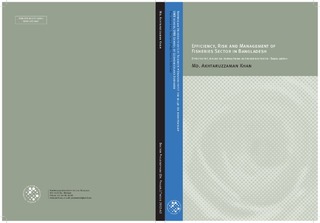| dc.contributor.advisor | Guttormsen, Atle | |
| dc.contributor.advisor | Roll, Kristin H. | |
| dc.contributor.author | Khan, Md. Akhtaruzzaman | |
| dc.coverage.spatial | Bangladesh | nb_NO |
| dc.date.accessioned | 2018-05-08T09:21:11Z | |
| dc.date.available | 2018-05-08T09:21:11Z | |
| dc.date.issued | 2012 | |
| dc.identifier.isbn | 978-82-575-1098-5 | |
| dc.identifier.issn | 1503-1667 | |
| dc.identifier.uri | http://hdl.handle.net/11250/2497507 | |
| dc.description.abstract | This dissertation consists of an introduction and five independent papers on Bangladesh fisheries sector. The first paper investigates how the fishery sector has developed and identifies the potential problems faced by the fisheries sector. Findings show that both fish production and productivity have increased for aquaculture and capture fisheries. Several problems, possible solutions and future prospects for fisheries sector are discussed in this paper. The second paper estimates the profitability and productivityfarm size relationship in aquaculture and investigates how smallholder farmers can sustain fish farming in the long run. It shows that the inverse profitability-farm size relationship holds but in general large fish farmers are more efficient, productive and profitable compared to small farmers. Access to credit and training are essential to sustain fish farming in the long-run. The third paper determines the production risk of pangas fish farming in Bangladesh. Results reveal that significant production risk exists in pangas farming. The use of large amount of fingerlings has risk increasing effects for all types of farms (small, medium and large farms) but feed usage is found to have a risk-increasing effect on production for large farms only, while the reverse holds in case of small farms. Findings suggest that access to credit and training in the fish farming can reduce production risk for smallholders. The fourth paper is on floodplain aquaculture where the impact on poverty and inequality of community-based aquaculture (CBA) system is investigated. We find that fish income and total household income is significantly and equally distributed after adopting this management system. Moreover, CBA management system can reduce the incidence and depth of poverty in the common resource areas. The fifth and last paper investigates whether excess capacity exists in gill-net fleet in the Bay of Bengal. If it does, then to what extent? And what are the policy alternatives for sustainable marine resource management? Results depict that the high degree of excess capacity exists in both monsoon and nonmonsoon seasons and more than one third of boats can be decommissioned. Licensing restrictions appear to be an effective instrument to eliminate the excess capacity from the fishery. However, this will have large distributional effects that need to be taken into account. | nb_NO |
| dc.language.iso | eng | nb_NO |
| dc.publisher | Norwegian University of Life Sciences, Ås | nb_NO |
| dc.relation.ispartofseries | PhD Thesis;2012:62 | |
| dc.rights | Attribution-NonCommercial-NoDerivatives 4.0 Internasjonal | * |
| dc.rights.uri | http://creativecommons.org/licenses/by-nc-nd/4.0/deed.no | * |
| dc.title | Efficiency, risk and management of fisheries sector in Bangladesh | nb_NO |
| dc.title.alternative | Effektivitet, risiko og forvaltning av fiskerisektoren i Bangladesh | nb_NO |
| dc.type | Doctoral thesis | nb_NO |
| dc.subject.nsi | VDP::Social science: 200::Economics: 210::Economics: 212 | nb_NO |
| dc.source.pagenumber | 164 | nb_NO |

